As a technology, Multi Jet Fusion (MJF) is a relative newcomer to the 3D printing scene. Despite its freshness, in just a few years MJF has started moving toward industrial-scale maturity – if it isn’t there already. Widely adopted by manufacturers, MJF has proven to be a reliable and consistent part fabrication technology for everything from car part and factory tools to orthopedic braces and consumer products.
The latest addition to the MJF family of 3D printers is the Jet Fusion 5400 Series, starting with the HP Jet Fusion 5420W Solution, launched in late 2022. It can print nylon parts in white instead of the usual dark grey. Sought after in the medical, automotive, and consumer goods industries, the new white material solution provides post-processing opportunities for more vibrant colors and better light refraction.

MJF has also been applied to footwear recently, not only in a new collaboration with French sport brand Decathlon, but also 3D printed concept sneaker with luxury brand Botter. The shoes are printed in a flexible TPU material, which was also the material of choice for cycling gear maker Posedla for its custom 3D printed bike saddle called the Joyseat.
Whether you’re looking to buy an MJF 3D printer or order MJF parts from a service provider, understanding the technology’s pros and cons and how to unlock its full potential will help you know if Multi Jet Fusion is right for your 3D printing needs. In this article, we will cover the basics of what Multi Jet Fusion 3D printing is capable of.
The Basics of Multi Jet Fusion

Multi Jet Fusion is a 3D printing technology introduced to the market by HP in 2016. The company explains its technology is built on decades of HP’s investment in inkjet printing, jettable materials, precision low-cost mechanics, material science, and imaging.
In a nutshell, the technology involves using a type of liquid binding agent to fuse together powdered polymer material layer by layer. The technology gets its name from the multiple inkjet heads that carry out the process of distributing the liquid polymer (or binding agent).
We go more in-depth into the process below, but know that MJF is fast, detailed, and has proved itself to be reliable, which is why there’s hardly a 3D printing service around that doesn’t have at least one MJF machine among its equipment.
Don’t confuse HP’s Multi Jet Fusion with its Metal Jet printing process used in its metal printers, which is very similar but uses metal powder instead of plastic. Our focus here is the Multi Jet Fusion technology, which only uses plastics.
The Multi Jet Fusion Process

Although MJF doesn’t fit neatly into one of the seven 3D printing technology categories defined by the International Standards Organization (ISO), it is a type of binder jetting. All binder jetting 3D printing technologies use a liquid material jetted by an inkjet printhead onto a layer of a powder material. Traditionally, plastic or polymer binder jetting is a “cold” technology, but HP (and a few others we detail below) introduced heat, which substantially alters the process. This is why MJF is sometime in a category of its own.
In the Multi Jet Fusion printing process, the printer lays down a layer of material powder on the printing bed. Following this, an inkjet head runs across the powder and deposits both a fusing and a detailing agent onto it according to the digital model of the parts required.
An infrared heating unit also moves across the print. Wherever a fusing agent was added, the underlying layer “melts” together, while the areas exposed with the detailing agent doesn’t fuse completely, but acts as a layer to ensure surface quality. Areas with no agent apply remain a powder. The unfused powder supports the fused material, which generally eliminates the need for supports.
To finish the printing process, the entire powder bed – and the printed parts in it – are moved to a separate processing station. Here, most loose unfused powder is vacuumed up, allowing it to be reused instead of producing excess waste.
The video from HP below goes into a little bit more detail but note that the last half is about what MJF could achieve in the future, not what it does today.
Industries Using Multi Jet Fusion
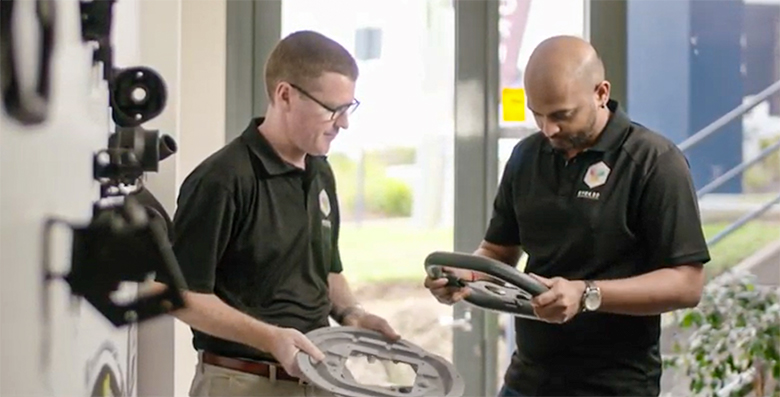
Multi Jet Fusion is a versatile technology that has found use in countless industries. It has helped manufacturers in all parts of their development processes, from prototyping to creating functional prototypes for field testing to manufacturing final parts.
Some industries that have found success with MJF include:
Automotive
MJF 3D printing is helping car and vehicle manufacturers reduce costs in parts production while boosting operational efficiency. A Spanish parts supplier (Continental Automotive Spain S.A.) for the automotive sector used MJF printing to develop a pneumatic gripper that helped them cut down on time when tooling new parts. At Jaguar Land Rover, car engineers are moving beyond brackets and interior trim and use HP Multi Jet Fusion to develop next-generation protective equipment for their factory workers. General Motors’ new 15,000-square-foot Additive Industrialization Center counts HP MJF machines among its 3D printing fleet for prototype parts, tools, fixtures, and end-use parts.

Medtech
The benefits of 3D printing and digital manufacturing during the pandemic continue to grow, bridging supply chain gaps and increasing speed of design-to-part. HP and its global network of partners and customers have 3D printed well over five million parts to fill urgent needs and convene new ecosystems that enable local manufacturing.
The medical and dental industries are experiencing an explosion of new 3D printed applications and mass personalization. The SmileDirectClub in Nashville, Tenn., has 60 HP Multi Jet Fusion printers working round the clock to make customized dental molds. HP Jet Fusion 3D printers are also changing the orthotics industry and enabling the production of customizable medical prosthetics. As one of the few pilate customers, Invent Medical manufactures custom orthotic and prosthetic devices with HP’s white PA12, offering up new post-printing coloring possibilities for pediatric care.
OVR Technology produces gadgets enabling the use of smell in virtual reality, targeting mainly the medical and therapeutic sectors. They were able to produce durable, highly detailed housings with complex geometry for their prototypes using MJF printers.

Consumer Goods
Many types of consumer goods require the production of low volumes of parts in complicated shapes. PepsiCo, one of the world’s leading food and beverage companies, found this out the hard way when they tried to design a small mask to go over drink cans as part of their product tie-in with the Black Panther movie.
The company tested various 3D printing technologies to replicate the fine details and the deep black color of the famous superhero’s mask. In the end, MJF came on top with the high production speed and durability it could provide.
HP also works with customers in the sporting goods and eyewear industry. Using Multi Jet Fusion, Oakley is reducing the product development stages of its eyewear selection as well as other athletic equipment. Moving from prototyping to end-use parts, Smith’s custom-fit 3D printed frame for the I/O MAG Imprint ski goggle was named one of Time Magazine’s Best Inventions of 2022.
Pros & Cons of Multi Jet Fusion
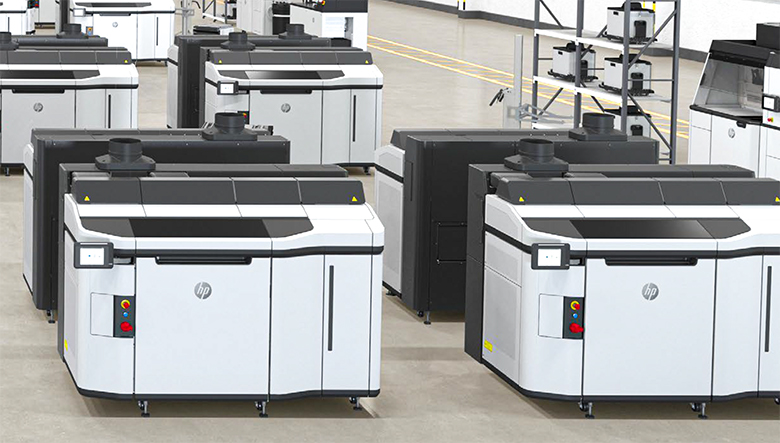
Pros
- Fast printing speed
- High volume production cycles
- Accurate printing for fine details
- Low individual print cost
- Design freedom as no supports are needed
- Less waste due to powder recycling
- Ability to color parts in post-processing
- High-quality surface finish
- Consistent mechanical properties
Cons
- Expensive initial printer investment
- All proprietary materials
- Unable to produce some curved, hollow geometries
- The final product is a gray without dying agents (except when printing with their new Jet Fusion 5420W Solution)
HP's MJF Machine Lineup
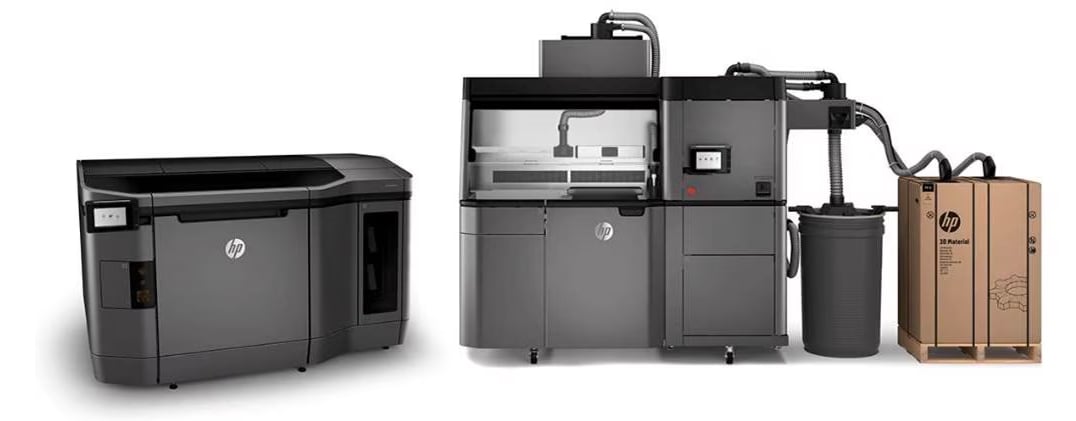
There are essentially two sets of HP Multi Jet Fusion 3D printers and accompanying equipment: the HP 3D Jet Fusion 4200 launched in 2016 (and has had some upgrades since) and the HP Jet Fusion 5200 Series launched in 2019. There’s also the 5420W launched in 2023, which is almost identical to the 5200 lineup except that the print system is dedicated to white parts only.
HP has had other MJF machines, mostly for prototyping, that are now retired.
The 4200
The 4200 series was HP’s first aimed at short runs and production volume parts. HP says it’s ideal for industrial prototyping and final part production environments.
Touted and an easy-to-use solution that can scale with your business, the 4200 uses HP’s proprietary fusing and detailing agents and materials. The system’s external tank enables the extraction of reused material from the processing station so it can be replaced with a different material.
An automated materials mixing and loading system streamlines your workflow and reduce labor. The suite of machines includes an enclosed unpacking and material collection system and a cooling module so you can remove a finished print bed and replaces it with a fresh one to minimize downtime.

The 5200
The 5200 series is HP’s dedicated 3D printer for volume production, meaning thousands or hundreds of thousands of parts. It features upgraded lamp power compared to the 4200 and a host of efficiency and speed advancements.
The 5200 Series includes variations — the 5210 and 5210 Pro — with various differences in running costs, volume, material compatibility, and internal component upgrades.
The 5420
This printer, post-processing station, and build unit is not capable of printing gray parts. It’s exclusive to the company’s white nylon PA 12 material.
One advantage of printing with white parts as opposed to gray or black is that white parts are easier to dye with brighter colors. Because dyeing MJF parts is very common, industry customers have been seeking a solution to produce brightly colored, end-use parts.
White parts produced on the 5420W have also passed tests for several biocompatibility specifications including cytotoxicity. Sterilization has also been successful up to 132 ºC undergoing multiple cycles at times ranging up to 30 minutes.
If you already have a 5200 series printer in your fleet and would like to upgrade to 5420, HP offers an upgrade kit.
Materials for Multi Jet Fusion
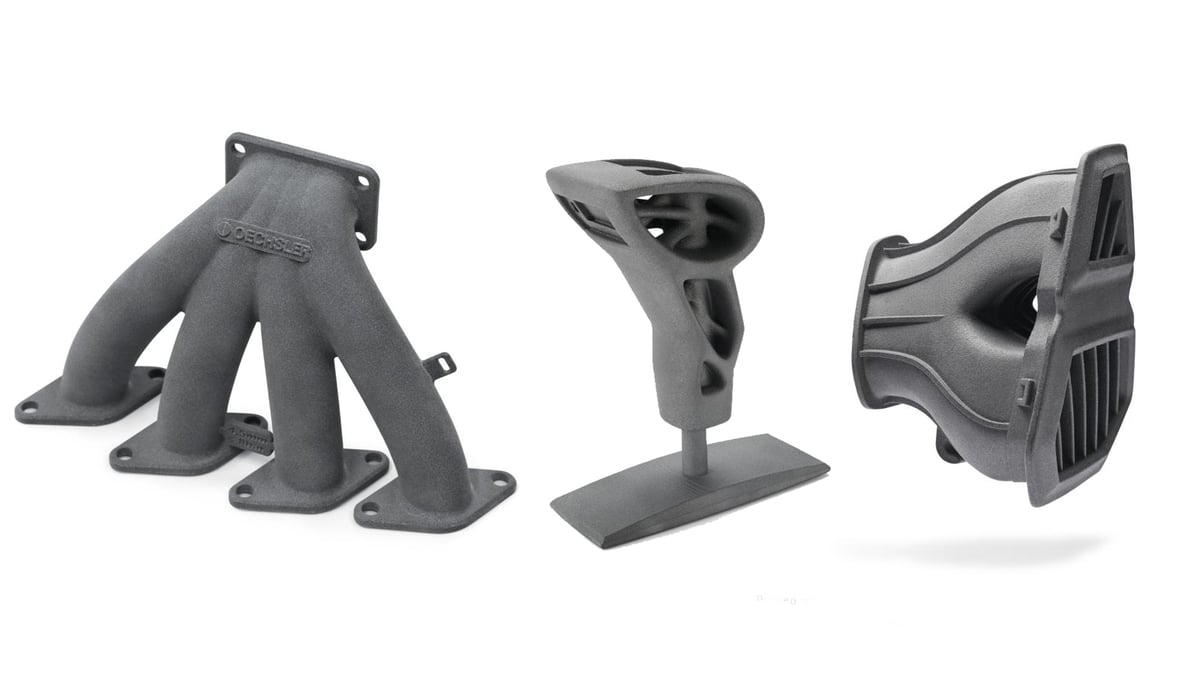
Initially, Multi Jet Fusion was only compatible with Nylon PA 12 powders. Although this is still the most common option, the breadth of available materials has expanded in the few years the technology has been on the market, with new ones still in development.
Although Multi Jet Fusion is a type of powder bed fusion, that doesn’t mean all powder bed compatible materials will work with MJF. In fact, the material list for MJF is much shorter than powder bed fusion, partly because it’s a proprietary HP process, but material manufacturers are responding to MJF’s growing popularity. In fact, in 2020, HP worked with BASF to develop a new durable and chemical-resistant polypropylene. Their latest addition is High Reusability PA 12 W, where the W stands for its white color and can be processed on their 5420W printing solution. Lubrizol also recently announced the launch of its latest MJF-compatible material, Estane 3D M88A TPU.
MJF-compatible materials include:
Rigid
- High Reusability (HR) PA 12 Nylon
- HR PA 12 Glass Bead (GB)
- HR PA 12 W (white)
- HR PA 11
- HR PP enabled by BASF Production
Flexible
- Estane 3D TPU – M95A from Lubrizol
- Ultrastint TPU01 from BASF
- TPA from Evonik/HP
- Estane 3D TPU M88A
Full-Color Printing With Multi Jet Fusion

HP used to offer its Multi Jet Fusion technology in full color, but sadly discontinued its HP Jet Fusion 380 machine in 2021. Several on-demand 3D printing services still have this printer, but HP no longer supports it.
If you’re looking for full-color 3D prints, check out the 3D Systems ProJet CJP 260Plus, the Mimaki 3DUJ-2207, or the Stratasys J750 and J55.
Buy a Printer or Outsource Your Printing
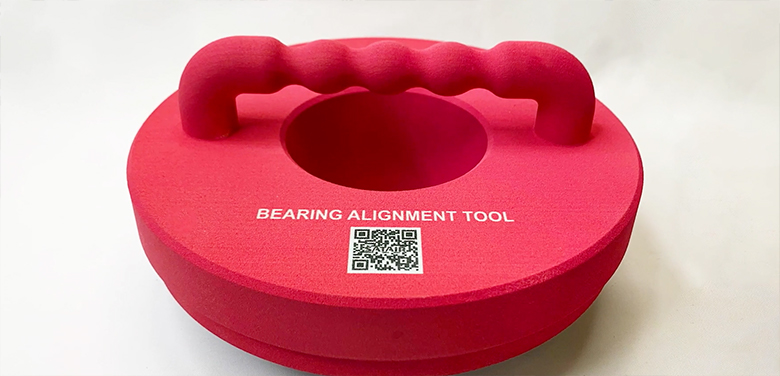
Although it provides a low unit costs than many other technologies, MJF 3D printers start at $100,000. Fortunately, most of the busiest on-demand 3D printing services worldwide have fleets of MJF printers at your disposal for one-off prints or ongoing serial production.
Because all MJF printers are manufactured by HP, all 3D printing services listed below can offer consistent part sizes and detail accuracies. This enables manufacturers to offer consistent part quality but localized production.
Just because all MJF printers are the same, doesn’t mean all MJF on-demand service providers are. When selecting your printing partner, focus on lead times, materials libraries, and additional services — such as coloring, polishing, chemical smoothing, design consulting, and NDA contracts — when choosing the best service for your purposes.
An easy way to pick the right third-party service provider for your needs is to use the 3D print price comparison platform Craftcloud, where you upload your part and MJF on-demand services provide quotes for you to pick from. Alternatively, check out our guide below to the top MJF 3D printing services.
Alternatives to Multi Jet Fusion
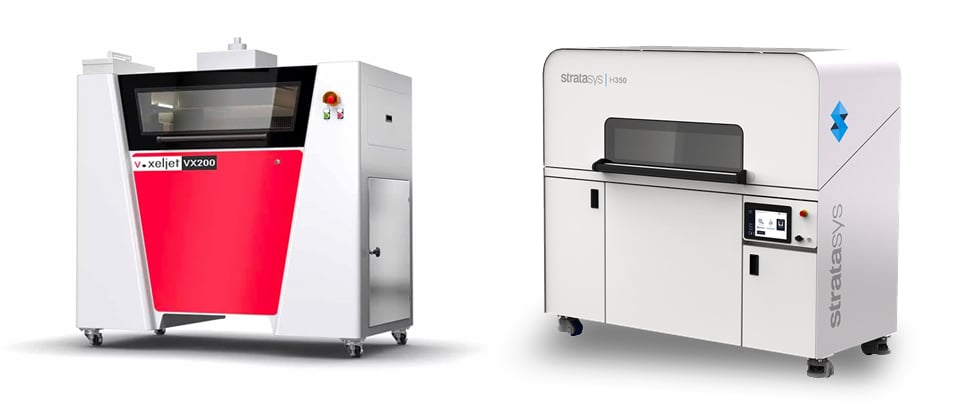
Selective Absorption Fusion (SAF), is another proprietary powder bed fusion technology that comes from 3D printer and material maker Stratasys. SAF uses an infrared absorption fluid to fuse particles of nylon powder together in layers to build parts. Industrial-grade piezo-electric print heads jet the fluid in prescribed areas to create each cross-section of the part. This is followed by exposure to infrared energy, which causes the areas with fluid to melt and fuse together. The sequence is repeated until the parts are completed.
Stratasys’ SAF 3D printer is the H350.
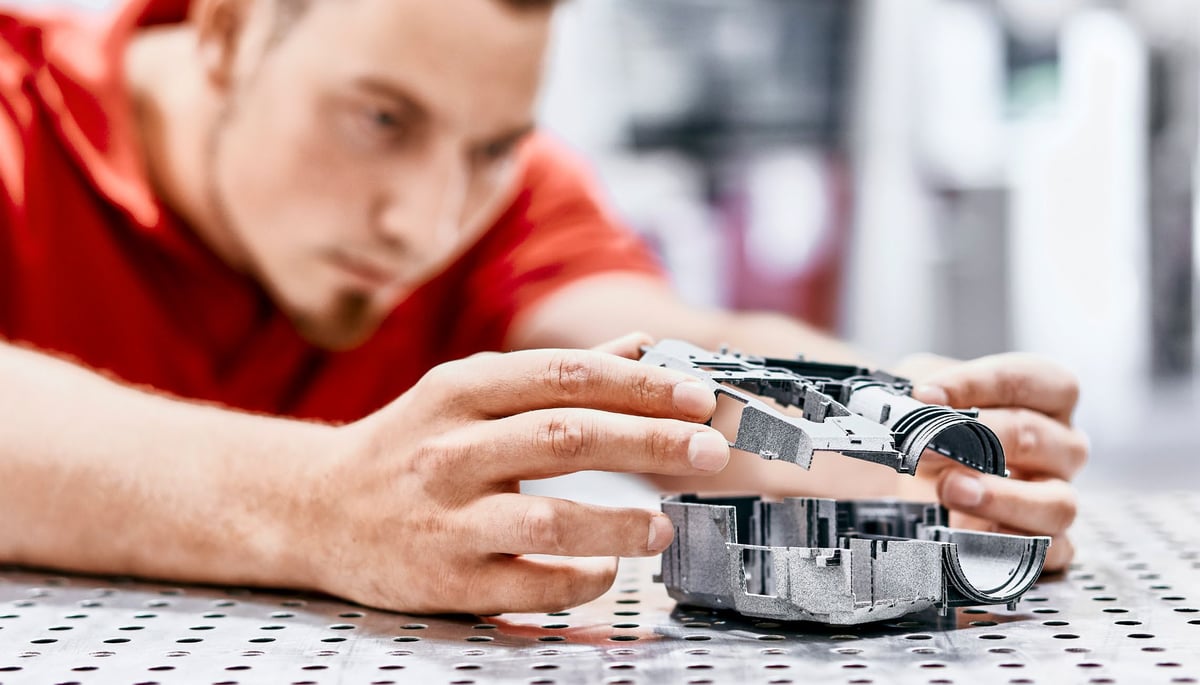
Like MJF, SAF is a faster method for producing nylon parts than technologies using lasers. Both of these methods have similarities to High Speed Sintering (HSS) from Voxeljet.
HSS has a large plastic range, including not only nylon and TPU but also to polypropylene (PP) and ethylene vinyl acetate copolymer (EVA).
License: The text of "Multi Jet Fusion (MJF 3D Printing) – The Ultimate Guide" by All3DP Pro is licensed under a Creative Commons Attribution 4.0 International License.


